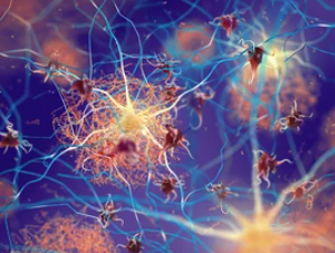Neurological Disease Research Using the iEM Platform
Electron microscopy (EM) has also been used in neuroscience research. As a cutting-edge tool, EM can produce ultra-high resolution images of neural structures and make the synaptic structure visible, which provide highly detailed datasets and an entirely new perspective in neuroscience research. Based on our integrated electron microscopy platform (the iEM Platform), Creative Biostructure can effectively and reliably advance multiple pathology research, including neurological diseases.
Neurological Disorder Research at the iEM Platform
- Explore the molecular and structural basis of neurodegeneration
Cryogenic electron microscopy (cryo-EM) can provide higher throughput and greater sensitivity in tissue imaging over traditional EM. Moreover, cryo-EM allows three-dimensional monitoring of fine structural processes at the cellular and molecular levels.? For cryo-EM of vitreous sections, the samples are processed in a frozen-hydrated state to keep their structure as close as possible to their true physiology. Therefore, the samples do not need any fixing or staining, excluding their associated r artifacts. Cryo-EM enables faithful structural information in situ down to molecular resolution.

Neurodegenerative diseases, such as Alzheimer"s and Parkinson"s diseases, are characterized by protein aggregation. The mechanisms of how aggregations cause neurotoxicity are unclear, partly because there is limited information available on the native structure of protein aggregates inside cells. Since determining the atomic structures of these protein aggregates is important to understand their formation, clearance, and spread in the human body, cryo-EM are increasingly used to provide high-resolution information on pathologically misfolded proteins extracted from diseased human brains. Our Cryo-EM enables ultra-high-resolution 3D imaging of sub-cellular objects as small as protein complexes and antigen-antibody interactions. Based on this advanced technology, we can assist customers to explore the molecular and structural basis of neurodegeneration.
- Characterize ultrastructural morphology of neuronal death in different pathological entities
Nerve cell death is associated with many factors, including anoxic-ischemic conditions of the tissue, the severity of brain edema, calcium depolarization, and so on. TEM can provide high-resolution images and is generally used in diagnostic pathology. Using TEM, we can provide the ultrastructural morphology of neuronal death. Based on strict morphological criteria, we are able to help customers to study nerve cell death following different pathological entities.
EM is an extremely versatile research tool in neuroscience research. For example, the exceptional quality and three-dimensional appearance of EM images allow easy interpretation and have greatly contributed to the understanding of neuronal organization and interactions. Creative Biostructure is at the forefront of the convergence of physical and life sciences. Our iEM Platform consists of a suite of advanced microscopy technologies, including scanning electron microscopy (SEM), transmission electron microscopy (TEM), confocal laser scanning microscopy (CLSM), atomic force microscopy (AFM), and corresponding accessories and software. We are able to provide all levels of technical support and consultation for our customers who need EM imaging and analysis. Talk to our experienced experts to get more information. contact us right now!
- Lewis, A. J., et al. (2019). "Imaging of post-mortem human brain tissue using electron and X-ray microscopy." Current opinion in structural biology, 58, 138-148.

